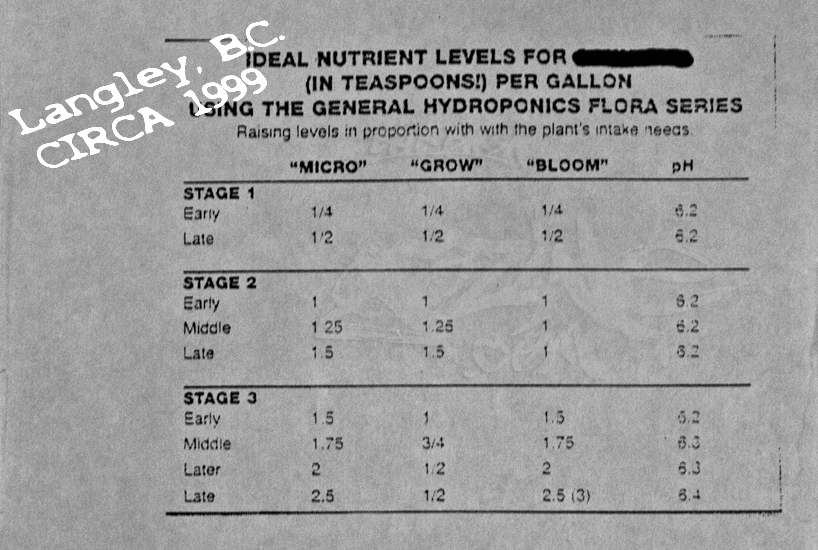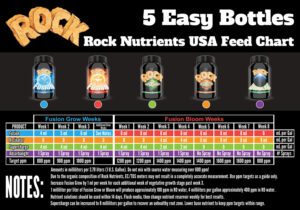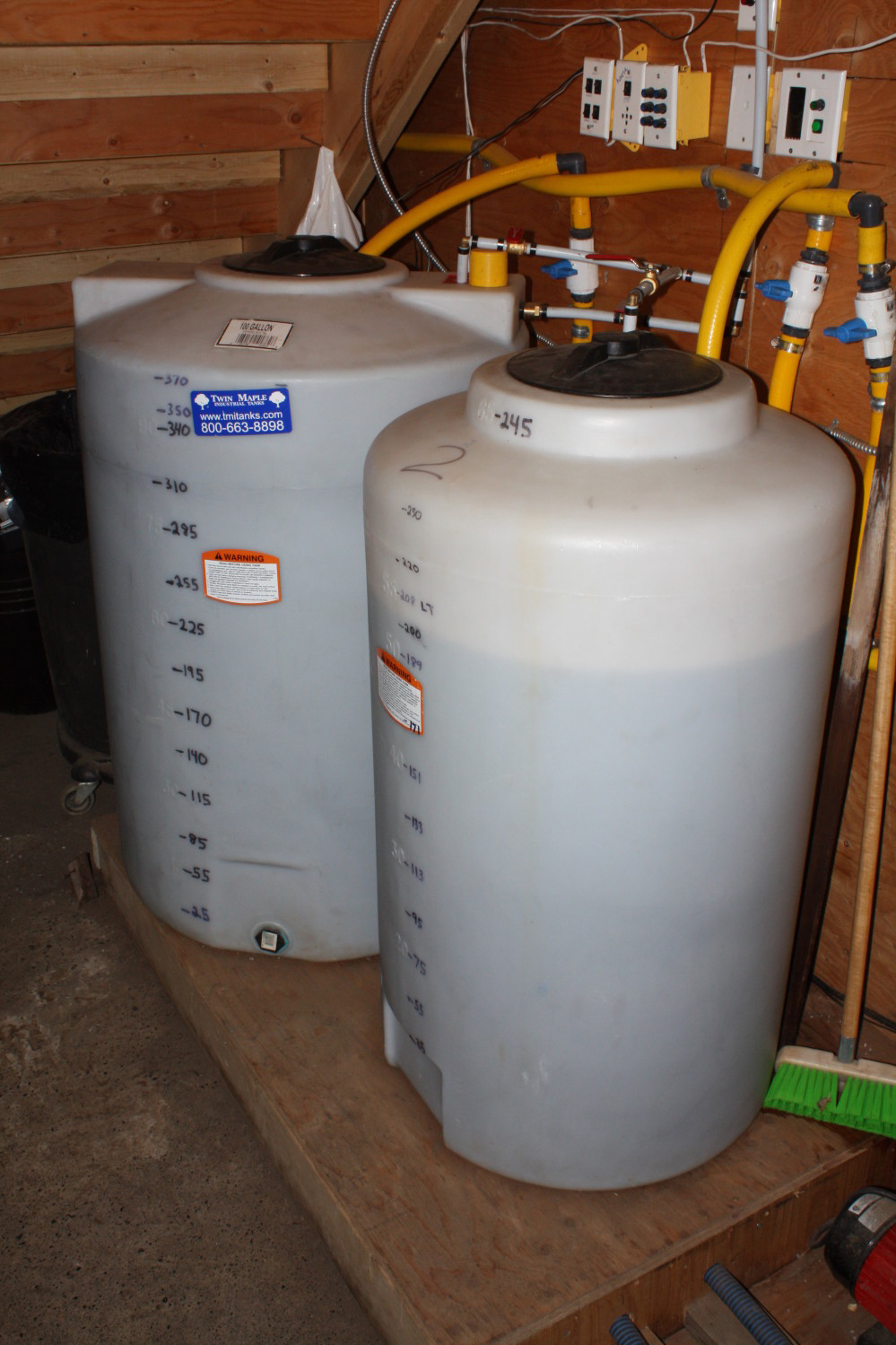Customizing Crop Feeding Programs, Some Things You Should Consider
Above: Early Feed chart, circa 1999
Below: Present Day Feeding Program-Click- to Read Full Screen
Customizing your crop feeding program to work better with your favourite plant strain(s) and the methods that you prefer to grow them in can be a very rewarding experience when you achieve bigger yields, although it’s not to say that you may not experience a few bumps on the road getting there.
Here are some tips and pointers about what you should be thinking about when customizing or creating your own custom crop feeding program.
Note that there are some differences for the type of growing medium, cropping style; we will lightly touch on some of these differentiations.
Do You Need To Stick With ALL One Brand of Hydroponic or Organic Nutrients and Fertilizers?
Usually, for the best results, NO. It’s rare or seemingly impossible for a single manufacturer to have every one of their products be the “Best in Class”. While there is something to be said for compatibility when it’s all from the same company, if you are trying to customize your own program you aren’t interest in a “Factory” Crop Feeding Program anyways. Looking at things in terms of “Classes” may help bring some clarity to what can initially be a little confusing.
Knowing Your Classes
While there are lots of different hydroponics fertilizers, supplements, boosters, teas, etc, etc out there, if you want to simplify things, there are some basic “Classes” of products that you can think in terms of:
- Rooting Hormone – for helping your cuttings develop roots faster
- Root Booster – this is different than above, because it is intended to add root mass quickly, once cutting have rooted or seedlings become established. This means you can transplant sooner, and that transplants will “take hold” quicker.
- Base Nutrients or Fertilizers – your Macro and Micro Elements…the “food, shelter and clothing” in terms of plant nutrition. with a good base nute, your plants really don’t need much more to do well, however, they will benefit from including other classes of products. This still remains the backbone of any good feeding program, so don’t sacrifice quality here so you can buy some flashy additive with the money you think you are saving. Organic bases are not recommend for purely hydroponic applications, while hydro-organics may be suitable for such purposes. Synthetics work in all types of growing situations
- Vitamin Tonics – almost always includes vitamin B-1, but may include others. Typically best applied early on from propagation to vegetative growth. Occasionally used in mid-flowering phase. Usually they contain other ingredients, and may include hormones, etc.
- Enzymes – these are great for breaking down organic residues in your growing medium. There’s some big differences from one to the next in this class in terms of how they interact with the root zone. Almost always a good idea to add the first time or two you re-use a growing medium.
- Teas – good for most phases including veg and bloom. Usually, these are bought or home brewed from organic materials and bases. While the nutritional value is minimal, they do tend to stimulate bio-activity in the growing medium or on the foliage if applied as sprays.
- Microbial Innoculants – these include fungi, bacteria and protozoa that co-exist within the plants root environment, or sometimes on the foliage and are said to have a “beneficial or symbiotic” relationships with plants. Most of the better ones work well, especially in increasing root mass and making plants hardier against things like nutrient stresses and salinity.
- Bloom Boosters – one of the most widely debated additives, ie what’s the best N-P-K fertilizer additive ratio and for what part of the bloom phase…some opinions include “not necessary, waste of money”. As a rule of thumb, bloom boosters with some potassium (K) kick are best in mid-bloom, while those with higher Phosphorous (P) and lower Potassium are better in the late bloom phase.
- Hormones – sometimes called “co-factors”, and sometimes derived from natural sources, these types of products can be engineered specifically for a single part of plant development or be formulated to be a general purpose “crop enhancer”. Responses range from increased metabolism, faster tooting, more flowering sites to denser blooms. Depends on what’s in the bottle, and that’s another topic.
- Flushing or Rinsing Agents – these are intended to help remove excess nutrients from the growing medium and/or from within the plant. Depending on which one you have, they may work in several different ways. With some, it is not advisable to re-use your growing medium-enzymes may be used as an alternate way to improve flushing for better taste and aroma in harvest
- Humates/Fulvates – these naturally occurring molecular chains help to condition the growing medium, ie soil, and plant for better nutrient absorption, transport and reduced stresses. These are often already present in most hydroponic crop supplements or even in hydro-organic base nutrients.
- Carbohydrates – widely debated, however, the consensus is that in soil and soilless mediums like peat, there are benefits to adding a spectrum of sugars with your crop nutrients and supplements-especially when e you combine them in a more organic based program.
- Calcium – Magnesium Supplements-if you use RO filtered or very pure water, you typically need to boost the Ca Mg levels over what is available in your base nutrients. Most of these products have a “greening” effect because they also have Nitrogen and Trace Elements like Iron.
Plus more…there are others, but let’s call the majority of those “secondary classes” for the sake of this article; more on that in the future:)
While this is a rather long (and potentially pricey) list of “stuff” for feeding your favourite plants, remember that you don’t use it all at once, rarely use it in the same quantities, ie smaller bottles of some stuff is all that is required and therefore will usually have even a smaller bottle of package of some of these products around for more than just one crop. It’s your Base Nutrients and staple additives like vitamins, Cal-Mag Supplements or teas that you are going to go through more readily.
Timing is Everything
WHEN you apply the plant nutrient product in the life cycle of the crop you are growing is of great importance. Some products are highly engineered for very specific purposes and are only beneficial when they are applied during the proper window of timing. Others are more “multi-purpose” or “broad spectrum” and get used in a wider range or even all applications in the plant’s life cycle. Just like how you might eat Carbohydrates before intense activity, and then Proteins to follow (energy, then repair)
Most products will give you an idea of when they are best applied from the label, but it still pays to do some research of your own.
Trial and Error
By following or adhering to a well known or recommended Factory crop feeding program you help to ensure a level of stability in your growing endeavour. However, the tendency is to start to customize over time as you gain experience, and you can use some of the ideas described here in doing so. It is advisable to only change a single variable at a time; or perhaps two “smaller” ones if you are impatient. This way you can actually see (and weigh or count) the differences at harvest with the changes you make, rather than guessing at what change resulted in what difference 😉
[ssba]



